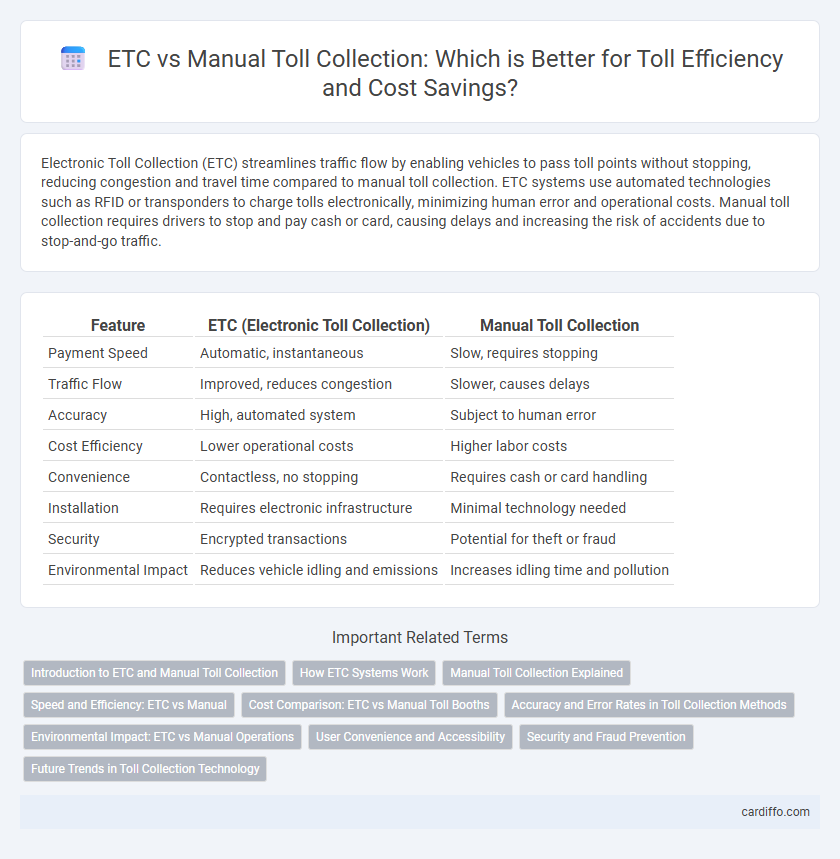Electronic Toll Collection (ETC) streamlines traffic flow by enabling vehicles to pass toll points without stopping, reducing congestion and travel time compared to manual toll collection. ETC systems use automated technologies such as RFID or transponders to charge tolls electronically, minimizing human error and operational costs. Manual toll collection requires drivers to stop and pay cash or card, causing delays and increasing the risk of accidents due to stop-and-go traffic.
Table of Comparison
| Feature | ETC (Electronic Toll Collection) | Manual Toll Collection |
|---|---|---|
| Payment Speed | Automatic, instantaneous | Slow, requires stopping |
| Traffic Flow | Improved, reduces congestion | Slower, causes delays |
| Accuracy | High, automated system | Subject to human error |
| Cost Efficiency | Lower operational costs | Higher labor costs |
| Convenience | Contactless, no stopping | Requires cash or card handling |
| Installation | Requires electronic infrastructure | Minimal technology needed |
| Security | Encrypted transactions | Potential for theft or fraud |
| Environmental Impact | Reduces vehicle idling and emissions | Increases idling time and pollution |
Introduction to ETC and Manual Toll Collection
Electronic Toll Collection (ETC) systems use RFID technology and automated sensors to allow vehicles to pass through toll points without stopping, significantly reducing congestion and improving traffic flow. Manual toll collection requires drivers to stop at toll booths to pay cash or use card transactions, often causing delays and increasing fuel consumption. ETC enhances toll efficiency by enabling seamless payments, while manual collection remains prevalent in regions lacking advanced infrastructure.
How ETC Systems Work
ETC (Electronic Toll Collection) systems use RFID technology, infrared sensors, or dedicated short-range communication (DSRC) to automatically detect and charge vehicles as they pass through toll plazas without stopping. Vehicles are equipped with transponders or tags linked to prepaid accounts or credit cards, enabling seamless and fast toll payments. This automated process reduces congestion, lowers emissions from idling vehicles, and improves overall traffic flow compared to manual toll collection.
Manual Toll Collection Explained
Manual toll collection involves drivers stopping at toll booths to pay fees directly to an attendant, offering a physical cash or card payment option often preferred in areas with limited electronic infrastructure. This system requires personnel for transaction processing and can cause congestion during peak hours due to slower vehicle flow compared to Electronic Toll Collection (ETC). Despite its slower pace, manual toll collection remains essential in regions lacking ETC adoption, supporting revenue collection and accommodating drivers without electronic transponders.
Speed and Efficiency: ETC vs Manual
Electronic Toll Collection (ETC) systems significantly enhance speed and efficiency by enabling vehicles to pass through toll points without stopping, reducing congestion and travel time. Manual toll collection requires vehicles to halt for payment, causing delays and increasing traffic buildup during peak hours. ETC's automation minimizes human error and operational costs, optimizing overall toll plaza throughput and commuter experience.
Cost Comparison: ETC vs Manual Toll Booths
Electronic Toll Collection (ETC) systems significantly reduce operational costs compared to manual toll booths by minimizing labor expenses and accelerating vehicle throughput, which lowers congestion-related economic losses. Implementation of ETC involves initial infrastructure investment but results in long-term savings through decreased personnel needs and maintenance costs. Manual toll booths incur higher ongoing costs due to staffing, cash handling, and slower processing times, impacting overall toll revenue efficiency.
Accuracy and Error Rates in Toll Collection Methods
ETC (Electronic Toll Collection) systems significantly reduce error rates compared to manual toll collection by automating vehicle identification and payment processing through RFID or ANPR technology. Manual toll collection is prone to human errors such as incorrect toll charges, miscounting vehicles, and data entry mistakes, leading to higher inaccuracies. The enhanced accuracy of ETC improves revenue collection efficiency and minimizes disputes between toll operators and drivers.
Environmental Impact: ETC vs Manual Operations
ETC (Electronic Toll Collection) significantly reduces vehicle emissions by enabling continuous traffic flow and minimizing idling time at toll plazas, whereas manual toll collection often causes congestion and increased fuel consumption. Studies indicate that ETC can lower carbon dioxide emissions by up to 40% compared to manual operations. Implementing ETC systems also decreases the environmental footprint by reducing the need for physical toll booth infrastructure and associated energy use.
User Convenience and Accessibility
Electronic Toll Collection (ETC) significantly enhances user convenience by enabling seamless, contactless payments without the need to stop, reducing travel time and allowing for faster, smoother traffic flow. Accessibility is improved as ETC systems are available 24/7, eliminating barriers such as cash handling or exact change requirements common in manual toll collection. Manual toll booths often lead to longer queues and delay, particularly during peak hours, which can inconvenience users with limited time or accessibility needs.
Security and Fraud Prevention
Electronic Toll Collection (ETC) systems enhance security by using encrypted vehicle identification and automated payment processing, reducing the risk of toll evasion and identity theft compared to manual toll booths. Manual toll collection is more susceptible to human error, cash theft, and fraudulent activities such as counterfeit payments. ETC's integration with real-time monitoring and data analytics provides robust fraud prevention, ensuring accurate toll charges and minimizing revenue loss.
Future Trends in Toll Collection Technology
ETC (Electronic Toll Collection) systems leverage RFID and DSRC technologies to enable seamless, contactless vehicle identification, drastically reducing congestion compared to manual toll collection reliant on cash transactions. Future trends emphasize integrating AI-powered analytics and blockchain for enhanced security, fraud detection, and dynamic pricing based on real-time traffic data. Autonomous vehicle compatibility and IoT-enabled infrastructure promise continuous improvements in efficiency and scalability across global toll networks.
ETC vs manual toll collection Infographic

 cardiffo.com
cardiffo.com